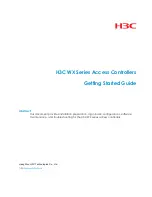
CHAPTER 1 Introduction
Mediant 4000 SBC | User's Manual
Configuration
Terms
Description
IP Profile
The IP Profile is an optional configuration entity that defines a wide range of
call settings for a specific SIP entity (IP Group). The IP Profile includes
signaling and media related settings, for example, jitter buffer, silence
suppression, voice coders, fax signaling method, SIP header support (local
termination if not supported), and media security method. The IP Profile is in
effect, the interoperability "machine" of the device, enabling communication
between SIP endpoints that "speak" different call "languages".
The IP Profile is associated with the SIP entity, by assigning the IP Profile to
the IP Group of the SIP entity.
Classification
Classification is the process that identifies the incoming call (SIP dialog
request) as belonging to a specific SIP entity (IP Group).
There are three chronological classification stages, where each stage is done
only if the previous stage fails. The device first attempts to classify the SIP
dialog by checking if it belongs to a user that is already registered in the
device's registration database. If this stage fails, the device checks if the
source IP address is defined for a Proxy Set and if yes, it classifies it to the
IP Group associated with the Proxy Set. If this fails, the device classifies the
SIP dialog using the Classification table, which defines various
characteristics of the incoming dialog that if matched, classifies the call to a
specific IP Group. The main characteristics of the incoming call is the SIP
Interface that is associated with the SRD for which the Classification rule is
configured.
IP-to-IP
Routing
IP-to-IP routing rules define the routes for routing calls between SIP entities.
As the SIP entities are represented by IP Groups, the routing rules typically
employ IP Groups to denote the source and destination of the call. For
example, to route calls from the IP PBX to the SIP Trunk, the routing rule can
be configured with the IP PBX as the source IP Group and the SIP Trunk as
the destination IP Group.
Instead of IP Groups, various other source and destination methods can be
used. For example, the source can be a source host name while the
destination can be an IP address or based on an LDAP query.
Inbound and
Outbound
Manipulation
Inbound and Outbound Manipulation lets you manipulate the user part of the
SIP URI in the SIP message for a specific entity (IP Group). Inbound
manipulation is done on messages received from the SIP entity; outbound
manipulation is done on messages sent to the SIP entity.
Inbound manipulation lets you manipulate the user part of the SIP URI for
source (e.g., in the SIP From header) and destination (e.g., in the Request-
URI line) in the incoming SIP dialog request. Outbound manipulation lets you
manipulate the user part of the Request-URI for source (e.g., in the SIP From
header) or destination (e.g., in the SIP To header) or calling name, in
outbound SIP dialog requests.
The Inbound and Outbound manipulation are associated with the SIP entity,
by configuring the rules with incoming characteristics such as source IP
Group and destination host name. The manipulation rules are also assigned a
Routing Policy, which in turn, is assigned to IP-to-IP routing rules. As most
deployments require only one Routing Policy, the default Routing Policy is
automatically assigned to the manipulation rules and to the routing rules.
- 4 -
Содержание Mediant 4000 SBC
Страница 1: ...User s Manual AudioCodes Series of Session Border Controllers SBC Mediant 4000 SBC Version 7 2...
Страница 40: ...Part I Getting Started with Initial Connectivity...
Страница 48: ...Part II Management Tools...
Страница 113: ...Part III General System Settings...
Страница 118: ...Part IV General VoIP Configuration...
Страница 525: ...Part V Session Border Controller Application...
Страница 654: ...Part VI Cloud Resilience Package...
Страница 663: ...Part VII High Availability System...
Страница 685: ...Part VIII Maintenance...
Страница 759: ...Part IX Status Performance Monitoring and Reporting...
Страница 844: ...Part X Diagnostics...
Страница 888: ...Part XI Appendix...
Страница 1036: ...This page is intentionally left blank CHAPTER 62 Technical Specifications Mediant 4000 SBC User s Manual 1003...















































